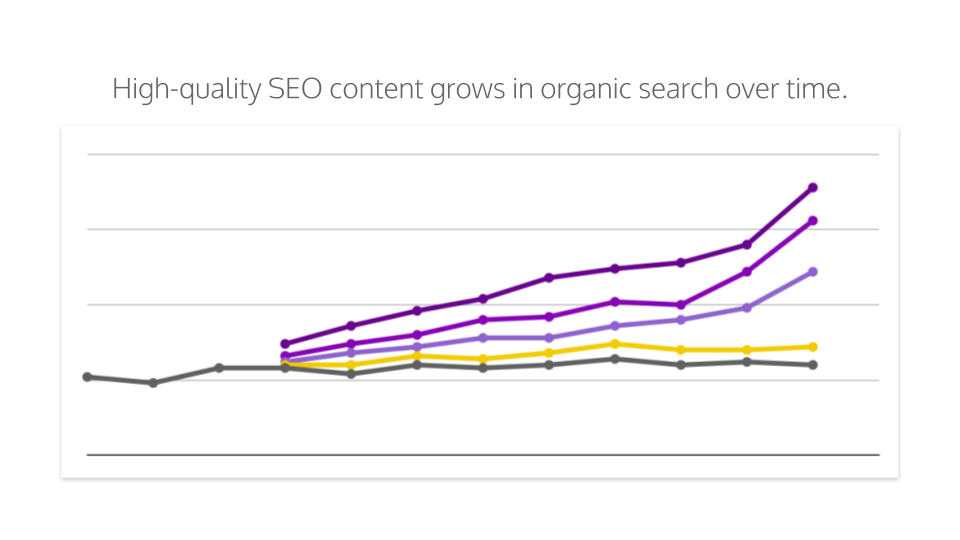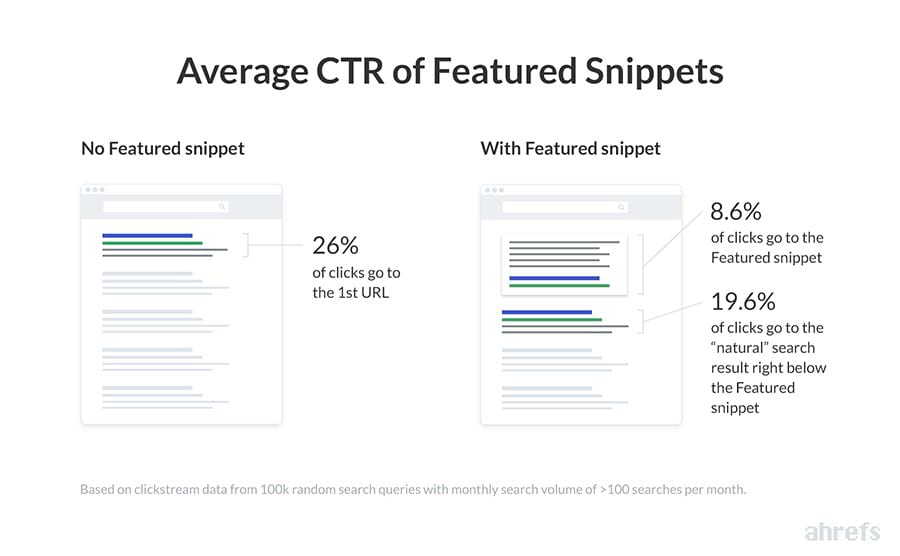Google Announces Featured Snippet Deduplication: Should Your Strategy Change?
Early last week, Google revealed a structural update to the first page of their search results, specifically related to featured snippets and organic rankings. Google is calling it “snippet deduplication.”
Danny Sullivan, Google’s Public Search Liaison, fielded a lot of questions from marketers who were, rightly so, asking how the change will affect their organic traffic. Many more are still wondering how this update should affect future SEO strategies.
As with most SEO considerations, a brand’s strategy needs to be guided by their goals and their audience—not by Google’s latest update. There are two main options to weigh, and both are detailed below (with a bonus option to consider as well).
Get the facts, align on goals, and make a plan.

Featured Snippet Deduplication: What It Means
Until last week, if a piece of content was elevated into Google’s featured snippet box at the top of organic search results, that URL was featured twice on the SERP: once in the featured snippet and once in a normal, organic snippet further down the page.
Google decided that this duplication of a URL on the same page of search results was creating a poor user experience.
As of last week, if a URL is highlighted in the featured snippet, it will no longer appear in a normal, organic snippet on page one of Google’s search results.
If a web page listing is elevated into the featured snippet position, we no longer repeat the listing in the search results. This declutters the results & helps users locate relevant information more easily. Featured snippets count as one of the ten web page listings we show.
— Danny Sullivan (@dannysullivan) January 22, 2020
It is worth noting that the sidebar featured snippets are not being deduplicated now. They were deduplicated when the update rolled out, but Google stopped that shortly after the update.
But that’s only because Google plans to remove those featured snippet variants and incorporate the featured snippet into the main column of search results very soon. The change will better mimic the mobile search experience, and when that happens, those featured snippets will be deduplicated.
We appreciate that concern. Hopefully this will ease it. This format is likely to appear in the main column as regular features snippets do within a month. And we’re likely to stop deduplication within it until that happens, maybe later this week.
— Danny Sullivan (@dannysullivan) January 23, 2020
There are a lot of SEO implications embedded within this change, and marketers have a few options to consider.
What Deduplication Means for an SEO Strategy
An effective, modern SEO strategy needs to resist the urge to react to every one of Google’s updates. As you consider your best strategy, keep two key considerations in mind:
- Focus on your ultimate SEO content goal(s), not the immediate algorithm update.
- There is no one-size-fits-all solution.
The pros and cons of capturing a featured snippet have been tested and studied, but there never has been clear consensus or majority strategy. Some report more traffic, others report less. Some correlate greater brand awareness, others don’t.
Google is not working with one-size-fits-all algorithms anymore, so our SEO strategies have to remain flexible as well.
So what does the featured snippet update mean for your strategy as you head into 2020? I’d like to recommend a simple, three-step process:
- (Re)establish the brand’s SEO goals. What is the ultimate aim? MQLs? Brand awareness? Does it vary per page/post? Keep the goal(s) front and center.
- Weigh your options. You can choose to target the featured snippet, opt out of the featured snippet, and/or target another SERP feature.
- Monitor your traffic and test, on repeat. Resist the urge to focus too much on rankings. Rankings are often a precursor to traffic, but organic traffic is more important. Rankings are nice, traffic leads to revenue.
Option 1: Targeting Featured Snippets
Create better-than-the-best content and follow best practices to target a featured snippet: echo the user’s question and provide a clear, concise answer, etc.
Some internal A/B testing that was generously published for the rest of us has shown improved CTRs when the brand’s content appeared in a featured snippet. We don’t know if that was because of the featured snippet, or because the URL—at that time—appeared twice on page one. But if your content is stuck on the bottom of the SERP, it might be worthwhile to target a featured snippet to try to leapfrog to the top.
Just don’t put all your eggs in that basket. Make sure the entire content piece is outstanding, so that even if it doesn’t capture the featured snippet, it can still keep earning its way to the top of organic results.

If you do manage to capture the featured spot, note the date and keep watching organic traffic. Is the featured snippet helping or hurting? If you catch organic traffic starting to dip, there are other options.
Benefits:
- Winning the featured snippet might improve organic traffic to that page.
- Winning the featured snippet will put your brand in front of more users, even if they don’t click, improving authority with your audience.
- Even if you don’t win the featured snippet, you’ve designed at least one part of your content to efficiently answer the user’s need—creating a better UX overall.
Risks:
- Winning the featured snippet might hurt organic traffic to that page.
Option 2: Opt Out of Featured Snippets
Create that same outstanding content and opt out of featured snippets. There are a few ways to opt out, including:
- nosnippet — This tag blocks featured and regular snippets for an entire page.
- data-nosnippet — This tag blocks certain text on the page from appearing in a featured or regular snippet.
The code allows marketers to target high organic rankings, but avoid the featured snippet.
An oft-quoted Ahrefs study suggests that the #1 organic position earns twice as much traffic as the featured snippet.

Other organic search studies suggest that the CTRs for the first several organic snippets might get more organic traffic than the featured snippet, but fail to make direct comparisons.
But no one can guarantee a #1 (or #2 or #3) organic ranking either.
A word of caution: If a page is elevated to the featured snippet, and the normal organic snippet is removed from the SERP, opting out of the featured snippet does not guarantee that the normal organic snippet will return to its previous ranking. When asked about this, Sullivan said that he “expects” it would, but stopped short of concrete assurances.
I would expect so. To be a featured snippet, you had to rank in the top results. Then we elevated. And now we deduplicate. If you don’t get featured, deduplication ends.
— Danny Sullivan (@dannysullivan) January 22, 2020
If multiple pages start to lose organic traffic after taking a featured snippet spot, opt out of a small percentage first and see what happens.
Benefits:
- Target top organic rankings without worrying about potentially losing traffic by being scraped into Google’s featured snippet.
Risks:
- Miss an opportunity to have the brand name and content highlight in a featured snippet.
Option 3: Target Other SERP Features that are Not (Yet) Deduplicated
A lot of the questions Sullivan answered last week started with, “What about [insert SERP feature]?”
Other SERP features don’t result in a repeated URL, so there’s always the option to put a little more focus on video, images, and news/top stories. It is still possible for a brand to get more than one spot on page one by being featured in an image box, video carousel, or Top news highlight.
Your SEO Strategy in 2020 and Beyond
Google is changing … eternally. An update to organic search results to improve the user experience shouldn’t surprise digital marketers anymore.
How should marketers respond? Remain calm, focus on the goal(s), weigh the options, and measure traffic to make data-driven decisions on the metrics that matter.
And, as always, keep producing SEO content that is better than anything already on the web. Not sure what that process looks like? Our Modern Guide to High-Impact SEO Content ebook will get you started.
What's Next?
Profound Strategy is on a mission to help growth-minded marketers turn SEO back into a source of predictable, reliable, scalable business results.
Start winning in organic search and turn SEO into your most efficient marketing channel. Subscribe to updates and join the 6,000+ marketing executives and founders that are changing the way they do SEO:
And dig deeper with some of our best content, such as The CMO’s Guide to Modern SEO, Technical SEO: A Decision Maker’s Guide, and A Modern Framework for SEO Work that Matters.





